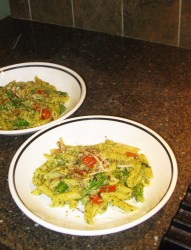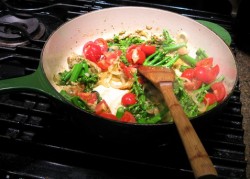Pesto: A Kat’s Favorite Dish
In the summer, I make pesto at least once or twice a week, and have been doing so for the last five or six years. I always plant an abundance of basil in the garden and then harvest it all summer long, enough to make a meal or two’s worth of pesto each week–so for years, Zak and I have been eating copious amounts of this delicious garlic and basil based sauce.
And what is cool is this–Kat loves it. She will eat pasta and chicken in shocking amounts, so long as it is slathered in pesto. So far, I cannot convince her that vegetables are good with anything–the tomatoes she loved for her first two years of life have turned into anathema, and she will nothing else that is green BUT basil or pesto, but I don’t let that stop me from adding any number of seasonal vegetables to the dish: sweet snap peas, french filet beans, onions, mushrooms of any sort, tomatoes, baby zucchini, and my new favorite combination–broccoli rabe and cherry tomatoes.
But no matter what vegetables I add, Kat avoids them–she just eats around them to get to the penne pasta and sauteed chicken slivers. (Just now, I convinced her to eat a carrot. And she did–amazing.) Now she eats both the pasta and chicken in amazing quantities for such a small person, so I guess that is something.
I realized when I posted about the new potatoes with pesto a couple of days ago that I had never really given my recipe for pesto. It isn’t really anything special, and I had never really written in down because I never really measured the amounts of the ingredients–I always just made it by eye and to taste.
And that is probably the best way to make pesto–to your own taste. You have to take into account the different strengths of flavor in each of the major ingredients: every garlic clove is not the same. Garlic varies widely depending on variety, freshness and where and how it was grown. Some of it is quite mild, some is hot and spicy and some is sweet.
Basil is similarly variable—depending once again on variety, where and how it was grown and how fresh it is. I like using a combination of Genovese–which is a pretty standard Italian broad-leafed variety of basil, and Greek columnar basil–which has smaller leaves and grows in a very tall, upright habit–which explains the kind of weird name. Genovese has a sweet flavor, which is intensified when grown in a moderately dry environment, while the Greek variety tastes a little bit spicier. Some folks really like Lemon Basil in their pesto, but I prefer it in salad dressings myself.
I tend to use fresh German Extra Hardy garlic in my pesto, which is grown right here in Athens by Rich Tomsu. His garlic is my favorite–it is amazingly strong in flavor, both sweet and spicy. I love the stuff. But when I use it, I don’t need to use as much of it as I would a regular supermarket variety. One or two cloves of it is enough for my basil when it is Rich’s fresh garlic, whereas the stuff from the store would take four of five cloves for the same effect.
Parmesan cheese differs greatly in flavor as well–it depends on how long it was aged, where it was made and how it is sold. Imported Parmesan sold in wedges, blocks or other-sized pieces has a superior flavor and salt content when compared to the shredded or shaved types sold in the dairy case at the grocery store. It is more expensive–but I have discovered that I don’t have to use as much of it as I would otherwise–because it is so strongly flavored. So, it kind of evens out.
Finally, the nuts–I use pine nuts in my pesto exclusively. I love walnuts, but I don’t like them in pesto–they are too strong and dark in flavor–I prefer the sweet, dare I say, “nutty” character of the pine nuts. I also toast them on the stove in a small cast iron skillet, shaking them over a flame until they are golden and fragrant, just before I make the pesto. This brings out their flavor, and adds an extra bit of character to the sauce.
Olive oil is important to the dish–always use the nicest oil you can afford. I like to use Italian or Greek extra virgin olive oil, because they can be peppery and fruity at the same time, as opposed to the Spanish oils which taste kind of grassy. (Which is good for salad dressings, but not so much for my pesto. I have never blended olive oil with another oil, though I have heard of folks slipping some almond or walnut oil into the sauce. I disagree vociferously with this–but to each his or her own. I will stick with the olive oil.
The only other ingredients I use are salt and either freshly ground pepper or Aleppo pepper flakes. I prefer black pepper, but because I sometimes react to it I don’t use it as much anymore. Aleppo pepper is not traditional–but it does give a sweet little burst of heat without tasting out of place in the sauce.
When you have as few ingredients in a sauce as we do with pesto–it behooves us to get the best we can afford and use them judiciously. I prefer home-grown basil, fresh, strong garlic, good peppery olive oil, imported cheese and toasted pine nuts–with a bit of kosher salt and Aleppo pepper in mine. Others may do it differently–remember this is a sauce to be made to taste. Some folks don’t like super-strong garlicky pesto–but I do. Some prefer the basil to stand out and leave the garlic in the background–I like them both to be up front and in your face. I like a deep green sauce that keeps your tongue dancing and your senses reeling.
Otherwise, its no fun.
And apparently, Kat agrees with me–just this evening, she asked if we could have pesto again, “Tomorrow?”
Tomorrow it is.
Pesto
Ingredients:
2-3 cups fresh basil leaves
2-5 cloves garlic–this depends on how garlicky your garlic is
1/2 cup toasted pine nuts–you can leave these out if you want, but I like them included–I don’t like walnuts, though
1/2-3/4 cup shredded Parmesan cheese
1/3-1/2 cup really good extra virgin olive oil–I tend to use less olive oil than other folks do
1/4 teaspoon Aleppo pepper flakes or freshly ground black pepper
salt to taste
Method:
Grind everything up in a food processor until a thick, green paste is formed.
What can you do with pesto?
You can obviously use it to dress pasta. Lots of vegetables can go with the pasta. Chicken is good with it. You can use it to top broiled or grilled salmon. Imagine cooking salmon with some tomato slices on top, and then spreading some freshly made pesto on top just before service.
You can toss it with baby new potatoes and cherry tomatoes. You can use it to flavor cream soups–it makes kick ass cream of potato soup. I bet it would be equally good with broccoli soup.
You can probably use it in mashed potatoes, too, so long as you didn’t mind that they were green!
7 Comments
RSS feed for comments on this post.
Sorry, the comment form is closed at this time.
Powered by WordPress. Graphics by Zak Kramer.
Design update by Daniel Trout.
Entries and comments feeds.





Your pesto recipe is remarkably similar to mine, except that I add lemon juice to mine, in addition to everything else. I don’t like really hot things, so I try to find sweeter garlic, and the lemon juice adds a nice zing.
Comment by Kymster — June 30, 2009 #
I love pesto! I wish I could grow basil, but my yard is less sun-kissed savannah than it is the deep, dark Amazonian rainforest. Sigh. Nonetheless I buy basil every week or two in summer and make pesto, pounding rhythmically in my big Thai mortar & pestle. I never measure anything but tend to go light on garlic and heavy on basil. Sometimes I add parsley as well.
Comment by Diane — June 30, 2009 #
My son is almost 9 and still loves pesto (and has since he was Kat’s age). I usually hide bits of other green vegetables in it when I’m blending the basil, such as spinach and occasionally green beans or zucchini. By the time the nuts and cheese are stirred in, the texture difference is unnoticeable. I don’t make pesto as often as I should, but do make a big batch at the end of the season right before the first frost when I rip all my plants out. Then I store it in the freezer in plastic containers topped with oil (with the cheese omitted), to try and keep the taste of summer going through the lonely winter months.
Comment by De in D.C. — June 30, 2009 #
I love pesto! I still have some in my freezer from last year when my CSA farmer had an abundance of basil and gave me a couple of paper grocery bags full!
I also like to experient with making pesto from other herbs, even though basil is awesome. A good cold-season alternative is to make pesto with arugula. Doesn’t taste the same, of course, but it is yummy. The nutty taste of the arugula goes great with the other ingredients, and it stays more bright green than basil pesto does.
Comment by Neohippie — July 2, 2009 #
Diane, my yard won’t grow basil either, do for Christmas by family bought us an aero garden! It works so well, and I buy the 5 pack of seeds that include 5 different varieties of basil. I make pesto all the time and also love having the extra basil because I throw it in eveything, especially home made tomato sauce. It grows so high I have to keep cutting it down and keeping it in a glass of water, otherwise it burns at the top from being too close to the bulbs. Anyway give it a try, you won’t regret it!
Comment by alexys — July 11, 2009 #
One thing that has always puzzled me about pesto recipes is the measurement of the leaves. The leaves are packed, right, but how much? You can lightly pack or really stuff them in there, and there can be quite a difference in amount of leaves, depending. Hmm–how about measurement by weight? (Or are basil leaves too light to measure accurately that way, either?)
(I’ve never had a great sense for ingredient proportions, so the measurements are really important to me.)
Comment by Laurel — July 20, 2009 #
Most of the time the measurement by weight wouldn’t work–not that many people have kitchen scales that are sensitive enough to less than an ounce of weight.
I usually tightly pack the basil leaves when I measure them.
Comment by Barbara — July 20, 2009 #